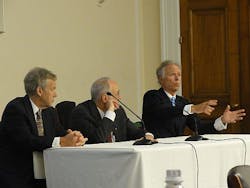Washington, DC--Several members of the optics and photonics community came together in Washington, DC, on September 12 to draw attention to the National Academy of Sciences’ (NAS) recently released report Optics & Photonics: Essential Technologies for Our Nation. Alternately known as Harnessing Light 2, the report discusses the current state of optical sciences and its possibilities for the future.
A special launch event—Essential Technologies for Our Future: Optics and Photonics Leading the Way—aimed at key stakeholders in US federal agencies, such as the National Institute of Standards and Technology (NIST), the National Science Foundation (NSF), and the Department of Energy, featured keynote addresses from US Secretary of Energy and Optical Society of America (OSA) Honorary Member Steven Chu and former Intel president and CEO Craig Barrett. Chu and Barrett highlighted the key role optics and photonics technologies play in driving economic growth, creating jobs, and enabling future innovations to advance society. Afterward, a briefing was held on Capitol Hill underscoring the same points to members of Congress and their staff. The events were co-sponsored by the OSA, the American Physical Society (APS), the IEEE Photonics Society, and SPIE.
“Optics and photonics are incredibly important to the U.S. economy and its competitiveness in the 21st century,” said Barrett in his address to an audience of 100 federal agency staff and other stakeholders. “Proposals like this [report] are critical to the US and it’s dreadfully important that policymakers not only accept them, but that they do something with it.”
The agency launch event also featured an overview of the NAS report’s findings by University of Southern California Professor Alan Willner, co-chair of the Harnessing Light Committee that authored the report, and a summary of the report’s recommendations by fellow co-chair Paul McManamon of Exciting Technology, LLC (Dayton, OH). For example, the report calls for a public-private partnership in the form of a National Photonics Initiative, which would focus attention and funding on photonics R&D, seek to clearly outline economic impacts and activities of the industry, and support collaboration across scientific sub-disciplines in which optics and photonics play a key role.
“It is our hope that the optics and photonics community will use the Academies’ report to bring private industry, universities and government partners together to enable greater economic growth and many more life-enhancing technologies through the expansion of optics and photonics,” says OSA vice president Philip H. Bucksbaum, who welcomed attendees to the event. “As the report concludes, the promise of optics and photonics can be realized if the United States acts now to cultivate this versatile scientific field through collaborative research and development activities and coordinated support from the public, academic and private sectors working together.”
The report was also laid out for a Capitol Hill audience as part of a Congressional R&D Caucus Briefing on Lighting the Way to American Prosperity. The event was kicked off by US Representative Rush Holt (D-NJ), co-chair of the Congressional R&D Caucus, and featured prominent optical scientists who have found success in photonics start-ups, including 2009 OSA President Thomas Baer of the Stanford Photonic Research Center (Stanford, CA), Greg Olsen of Princeton University (Princeton, NJ), and Martin Richardson of the Townes Laser Institute at the University of Central Florida (Orlando, FL).
“Today, US agencies and institutions are facing difficult funding decisions due to looming budget cuts and a tight fiscal climate,” Bucksbaum says. “As the federal government determines how to prioritize funding levels for science and technology programs, our community can use this landmark study to support those decisions, as it provides specific examples of the technological and economic value of optics and photonics in a broad range of sectors.”
The NAS study, which is a follow-up to the NAS’s Harnessing Light report published in 1998, identifies the technological and economic opportunities optics and photonics have enabled, assesses trends in market needs, gives examples of where progress in photonics innovation has translated into economic benefits, and makes recommendations for future research and policies that are intended to advance the optics and photonics discipline.
The report examined the use of optics and photonics in eight content areas—communications, information processing, and data storage; defense and national security; energy; health and medicine; advanced manufacturing; strategic materials; and displays—focusing on the enabling nature of optics and photonics and their role in facilitating economic growth. The Harnessing Light Committee members also made a number of specific recommendations on how to best capitalize on the opportunities optics and photonics provides.
For more information, please visit www.osa.org/HarnessingLight.
-----
Subscribe now to Laser Focus World magazine; it's free!
